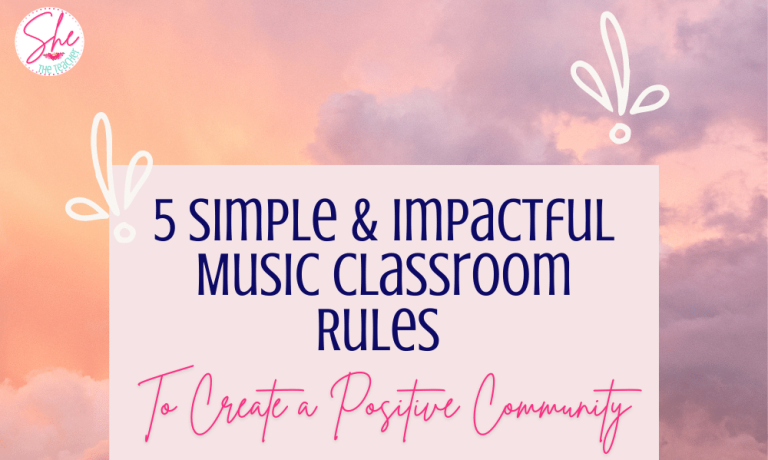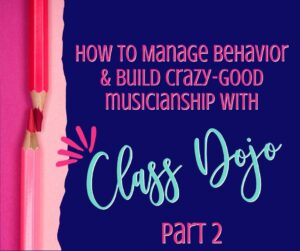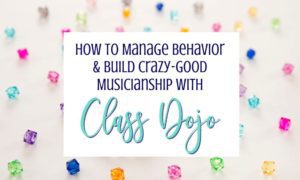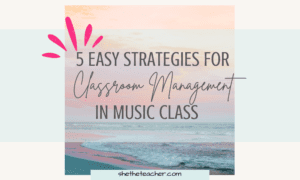Music is a beautiful thing. It has the power to bring people together, make us feel happy, and help us express ourselves. But for music to do all of those things, we need to create a positive community in our classrooms and set boundaries for student conduct and behavior through music classroom rules.
That’s why today, we’re going over five simple yet powerful rules that will help you teach students how to create a positive community in your music classroom. Not only are these rules easy for students to remember, but they get to the heart behind what creates a welcoming atmosphere in a way that your teen and tween students can understand.
So without further ado, let’s get started on how to introduce students to the rules and explain them in a way that makes sense!

Music Classroom Rule # 1: M= Make Today Positive
The first rule is, “Make Today Positive.”
What does that mean? It means that no matter what happens today, you should focus on progress and not dwell on the past without attempting to move through it.
Now, this doesn’t mean that you ignore problems when they come up, or put on a fake smile when something is wrong. But it does mean that you actively look for ways to make the situation better and move forward. “Positive” doesn’t mean you have to be fake, but it does mean that you make the choice every day to put what’s going on outside of class on the shelf and leave your problems at the door. Music class should be a place of healing and openness. Actively bringing in our problems and forcing others to deal with our bad day won’t help it get better, it will just make it worse for everyone else.
So, how do we teach students to handle a bad day?
We might teach them to:
- Ask for a minute right outside the door to collect themselves
- Request to sit somewhere else for the day
- Request a mindful activity for the class
- Request to hold a calming device during the day (not their phone)
- Explain up-front what’s going on in their day and ask for extra space and grace today
- Ask for advice or the advice of a counselor (and then participate until they can be seen)

Music Classroom Rule # 2: U= Understand and Respect Changes
The second rule is, “Understand and Respect Changes.”
What does that mean? It means that we should always be trying to understand why things are the way they are, and then actively working to respect the decisions that have been made – even if we don’t agree with them.
Now, this doesn’t mean that we should agree with everything. If something doesn’t feel right, we should absolutely speak up and share our concerns. But it does mean that we should always be coming from a place of understanding, not judgement. We should try to see things from other people’s perspectives and respect their opinions, even if we don’t share them.
So, how do we teach students to handle changes?
We might teach them to:
- Honor the space and rules of a substitute teacher, whose changes are only temporary, but just as valid.
- Attempt to view changes through the lens of curiosity and a “Let’s Try It and See What Happens” attitude.
- Talk to the person who made the change to try and understand their reasoning behind it.
- Attempt to find a compromise that works for both parties at a convenient and non-disruptive time.

Music Classroom Rule #3: S = Stand Up and Include Everyone
The third rule is, “Stand Up and Include Everyone.”
What does that mean? It means that we should always be working to make sure that everyone feels included in our community, and that we’re not tolerating any kind of bullying or harassment.
This rule is about more than just being nice to people. It’s about creating an environment where everyone feels safe, respected, and like they belong. It’s about making sure that we’re not complicit in any kind of hurtful behavior, even if we’re not the ones directly doing it.
So, how do we teach students to handle exclusion?
We might teach them to:
- Use “I” statements to explain how they’re feeling. For example, “I feel left out when you keep talking about the party without inviting me.”
- Attempt to include others in the conversation and activity. For example, “Hey, do you want to come sit with us?” or “Do you want to join our game?”
- Be respectful of others’ playing and singing abilities by not making fun of them or including them only when it’s convenient.
- Actively seek out students who are on the periphery or might need a buddy.
- Talk to someone they trust about how they’re feeling. This could be a teacher, guidance counselor, parent, or friend.
- Report any kind of bullying or harassment to a trusted adult.

Music Classroom Rule #4: I = Insist on Excellence
The fourth rule is, “Insist on Excellence.”
What does that mean? It means that we should always be striving to do our best, and not settling for mediocrity. It means putting in the extra effort to make sure that we’re always learning and growing.
This rule is about more than just getting good grades or performing flawlessly. It’s about setting high standards for ourselves and always challenging ourselves to reach new levels. It’s about pushing ourselves, even when it’s difficult because we know that it’s worth it. It’s about standing up for always being better than we are.
So, how do we teach students to insist on excellence?
We might teach them to:
- Practice regularly and put in the extra effort to get better.
- Always be prepared for rehearsals and performances.
- Be open to feedback and willing to make changes based on that feedback.
- Take risks and try new things, even if they’re difficult.
- Persevere when they make mistakes and don’t give up (growth mindset).
- Doing the right thing, even when no one is around.

Music Classroom Rule #5: Care for Our Space and Stuff
The fifth and final of the music classroom rules is, “Care for Our Space and Stuff.”
What does that mean? It means that we should take care of our belongings and the spaces that we use. It means respecting other people’s things and not being careless with them. It means keeping our practice and performance spaces clean and organized.
This rule is about more than just being tidy. It’s about taking pride in our belongings and respecting the property of others. It’s about being mindful of our impact on our local and larger spaces, places, and environment and taking steps to reduce that impact. It’s about having pride in who and where we are and showing that by allowing others to walk into a cared-for space. It’s about having integrity when things get broken and owning up to doing better.
So, how do we teach students to care for our space and stuff?
We might teach them to:
- Put away their belongings neatly at the end of each class.
- Help clean up spills or messes that they see, even if they didn’t make them.
- Recycle when possible.
- Report any damage or broken items to a trusted adult right away.
- Be careful with other people’s belongings and treat them with respect and help repair them or replace them if they are broken.
- Leave everything better than you found it.
The Big Idea
These five music classroom rules are designed to help create a positive and inclusive community in which students can learn, grow, and excel. It’s not about being perfect, but it is about building honesty, care, truthfulness, inclusion, and mutual respect for everyone who walks into our room. Implementing these rules can help to create a stronger classroom management plan and create a more positive and productive learning environment for all students (and YOU!). I hope they are meaningful and helpful!
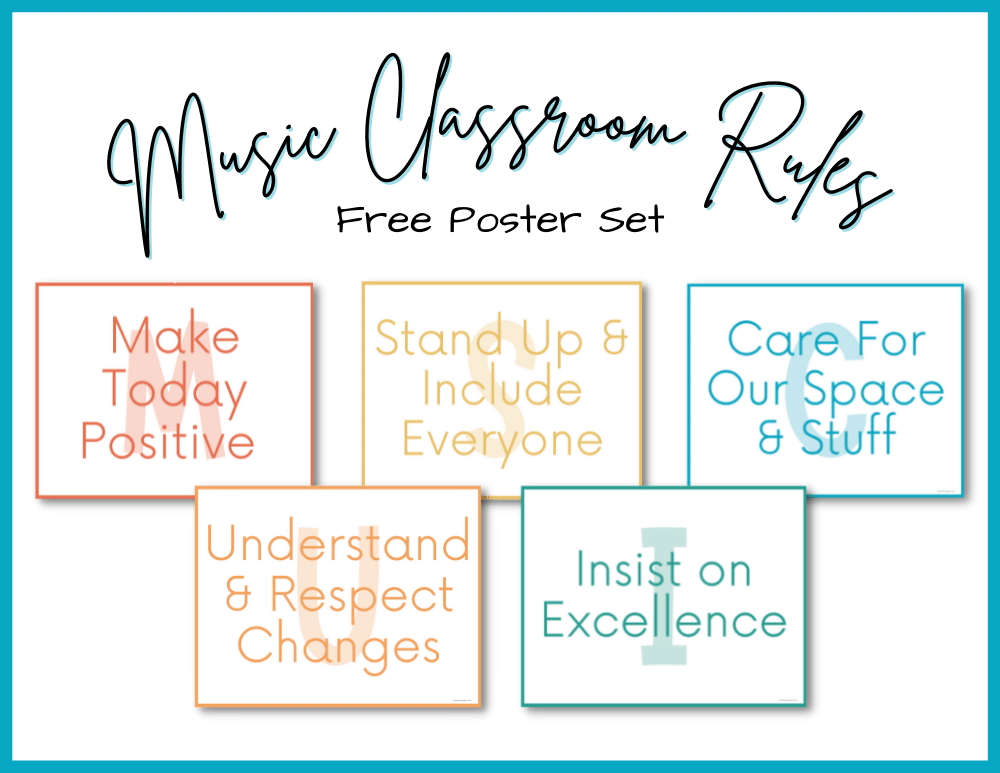
Free Rule Posters!
Want a free collection of the rule posters? Enter your info below!
P.S. If you like these posters, you’ll love the rest of the Sherbet Collection here.
Final Thoughts
Music teachers, what other rules do you have in your classroom? Share them in the comments below!

